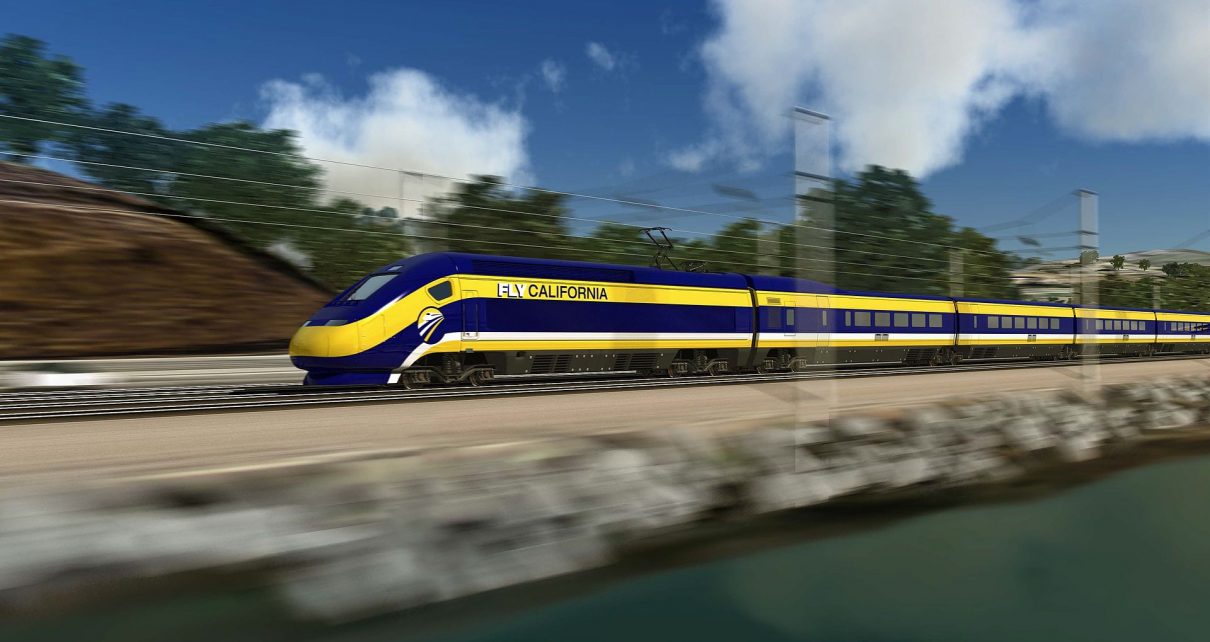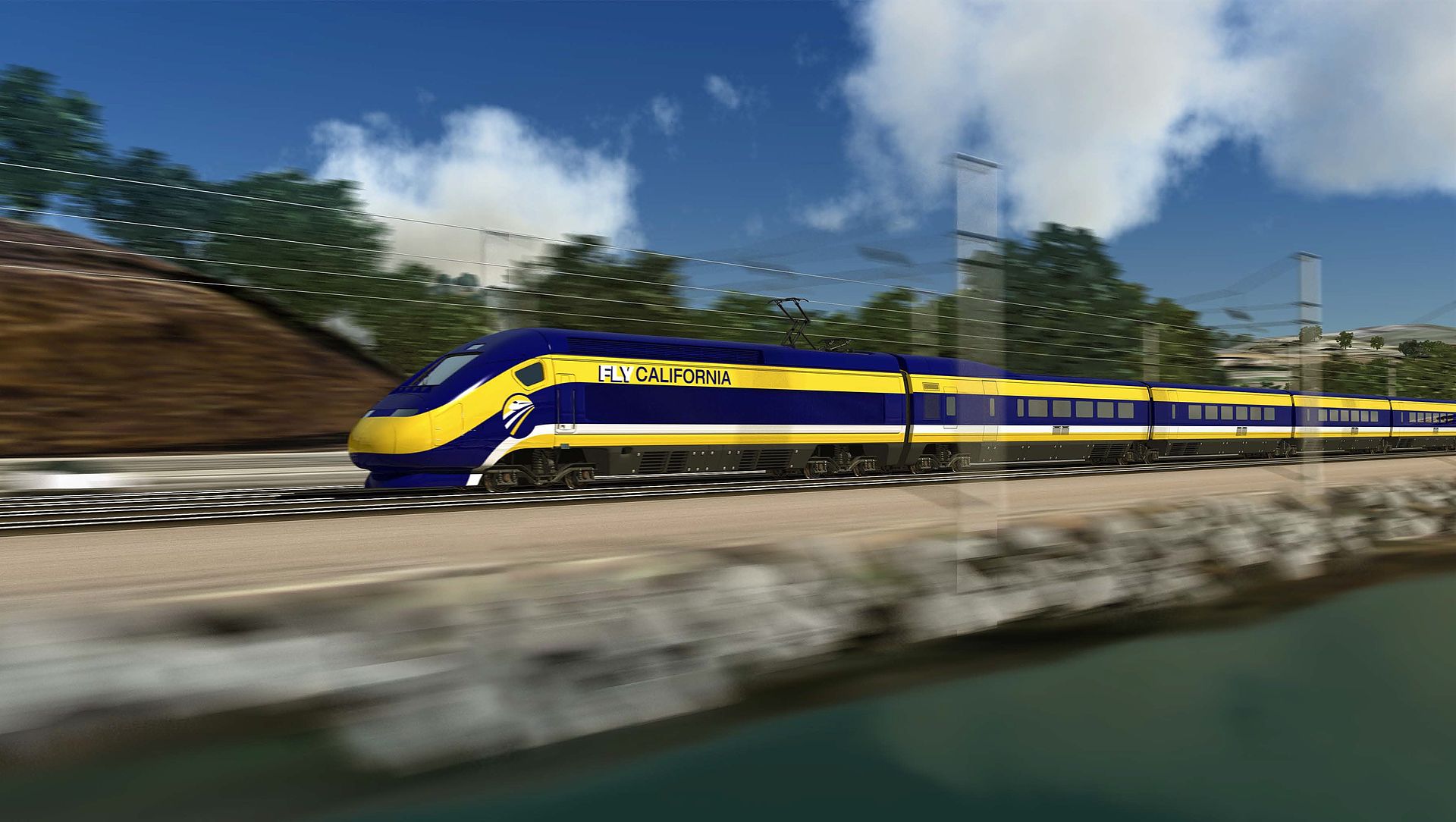
High Speed Rail train, artists rendering. (Photo: CHSRA.ca.gov)
Are Wasteful California Rail Projects Falling Out of Fashion?
Bay Area transit agencies should expect to face competitors across the country with more urgent needs benefitting more people
By Marc Joffe, January 24, 2023 9:59 am
Recent action at the state and federal level may bode ill for three costly projects being pursued by San Francisco Bay Area transit agencies. In the face of declining population and historically low transit ridership, the agencies are trying to corral $45 billion of both local tax revenues and state and federal funds to launch the projects. A better approach would be to shelve them.
Furthest along of the three projects is the $9.4 billion, four-station extension of the San Francisco Bay Area Rapid Transit (BART) system to and through Downtown San Jose. Although the six miles of additional track will carry BART trains, the extension is being built by a separate agency, the Santa Clara Valley Transportation Authority (VTA). A previous VTA-built extension, from Alameda Country to north San Jose, was delivered four years late. The two new stations added by this $2.3 billion, ten-mile project currently serve less than 2000 exiting passengers each day.
The follow-up project, expected to provide service in 2034, is already impacting the neighborhood despite not having federal funding in place: VTA recently voted to tear down a building housing eight residential units and three buildings to eventually build passenger egress and ventilation facilities.
Second is a $6.7 billion extension of Caltrain to San Francisco’s Salesforce Transit Center from its current terminus in the periphery of the city’s downtown. Caltrain ridership is down two-thirds since 2019, so utilization of this 1.3-mile extension will be limited. The project is targeted for 2032 delivery but a previous underground transit project in the area, the Central Subway, opened four years late.
The project’s sponsor, the Transbay Joint Powers Authority (TJPA), previously built a $2.2 billion transit center in downtown San Francisco that had to be closed weeks after its official opening due to a structural defect.
Finally, and in an earlier stage of planning, is Link21, which would build a second tunnel under the San Francisco Bay connecting Oakland to San Francisco. The project has a 2040 target date and a preliminary price tag of $29 billion. But the current BART tunnel is nowhere near full utilization in the pandemic’s aftermath, and hundreds of millions are already being spent to upgrade this tunnel’s signaling system so that it can accommodate two-minute headways, rather than the minimum 2:30 gap between trains now in force.
These three projects would likely post modest ridership numbers once completed, given the shift away from commuting and toward remote work that is especially pronounced in the tech-heavy Bay Area. And, even before the pandemic, population and transit ridership in the region had stopped growing due to the area’s high cost of living, as well as crime and cleanliness issues on transit systems.
Perhaps for these reasons, state and federal authorities are recognizing that bloated Bay Area transit projects are not the best use of scarce taxpayer funds. California, for example, has swung from a $100 billion surplus to a $22.5 billion projected deficit within the space of just one fiscal year and is looking for savings.
To help close the projected deficit, Governor Gavin Newsom’s January budget proposal cuts capital funding for California transit projects over the next three years. The money will come out of the state’s Transit and Intercity Rail Program which funds “transformative capital improvements that will modernize California’s intercity, commuter, and urban rail systems,” among other projects. Some of this money would likely have gone to one or more of the Bay Area megaprojects.
It remains to be seen whether this cut materializes. Newsom’s budget promises to restore funding if actual revenues exceed projections, while Senator Scott Wiener and several legislative colleagues are petitioning Newsom to rethink the planned reduction.
Meanwhile, the East Bay Times reported the federal Department of Transportation declined to fund two grant proposals from California High-Speed Rail Authority totaling $1.3 billion. It also passed on a request to contribute $88 million to the estimated $147 million cost of relocating Madera’s railway station, which now serves Amtrak only, but would also serve High-Speed Rail if, and when, the system begins operating. The cost of the proposed station project amounts to over $2,000 for each of Madera’s 68,000 residents.
These high-speed rail reversals may not be permanent, though. The unsuccessful applications were to DOT’s Mega Grants Program, which is only one of several in which HSR projects can participate. Due to the limited size of the Mega Program, the feds could only fund nine of 128 eligible programs.
But the federal decisions do not bode well for the Bay Area transit projects. Although the bipartisan infrastructure bill authorized $550 billion of new spending, only a small portion of that is available for transit projects: broadband internet, clean drinking water, and roads are all slated to get larger shares. And Bay Area agencies will struggle to compete with projects that have more compelling justifications.
In the recent Mega funding announcement, the Feds also passed on TJPA’s initial attempt to secure funding for its Caltrain extension, noting the insufficiency of local revenue sources and the applicant’s lack of technical capacity to execute the project. Instead, the Department of Transportation opted to fund the replacement of crumbling, 100-year-old bridges on a commuter rail line north of Chicago and a project to improve safety and add bus rapid transit to Philadelphia’s Roosevelt Boulevard.
As the federal Department of Transportation announces other bidding opportunities, the Bay Area transit agencies should expect to face other competitors across the country who have more urgent needs and projects that could benefit more people.
Bay Area transit officials often justify their expansion projects in terms of climate change. But whatever one thinks about the human role in warming the planet, it is hard to argue that these three projects are a cost-effective way of reducing greenhouse gas emissions.
Furthermore, their long execution times mean that none of them will provide any emission savings at all before 2030, a year that Green New Dealers had previously identified as the drop-dead date for achieving net zero emissions. Instead, these projects will all come online much later, at a time when most Californians will be adopting to the state’s forthcoming ban on internal combustion engines.
- California Shifts Blame for High Gas Prices - August 8, 2023
- Are Wasteful California Rail Projects Falling Out of Fashion? - January 24, 2023
- California Needs to Reassess Stay-at-Home Orders to Prevent an Economic Tragedy - April 20, 2020







Waste is never out of fashion since the democrats started ball harvesting.